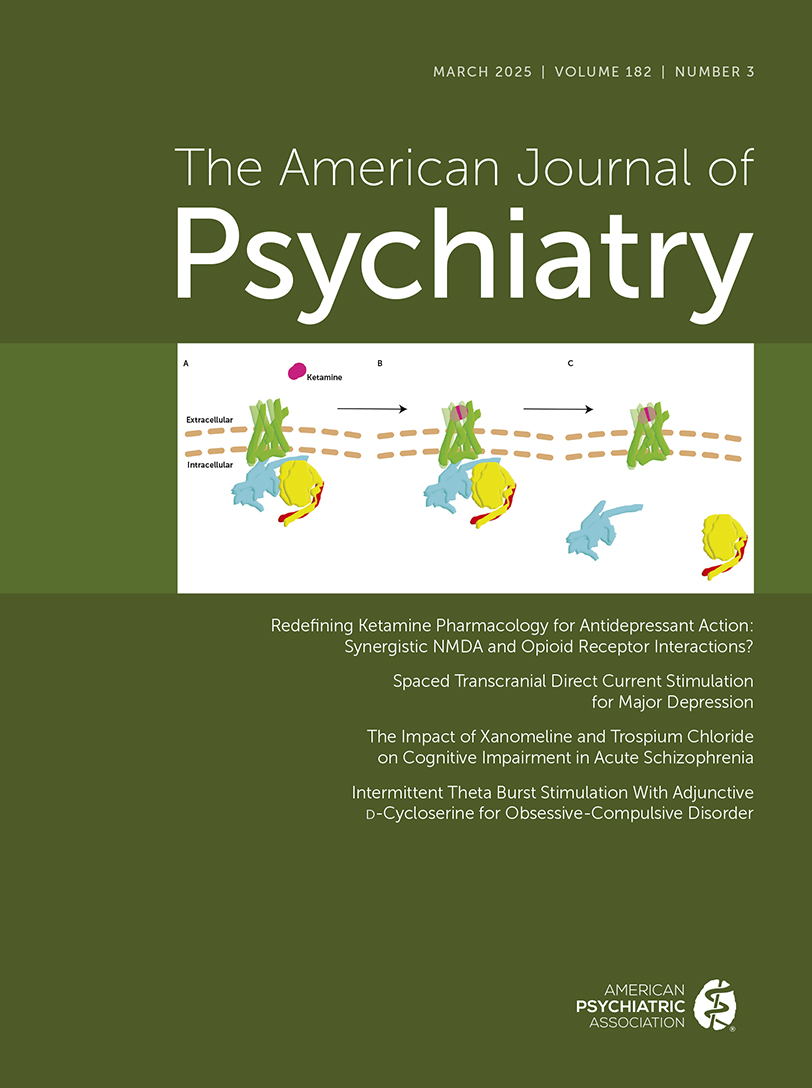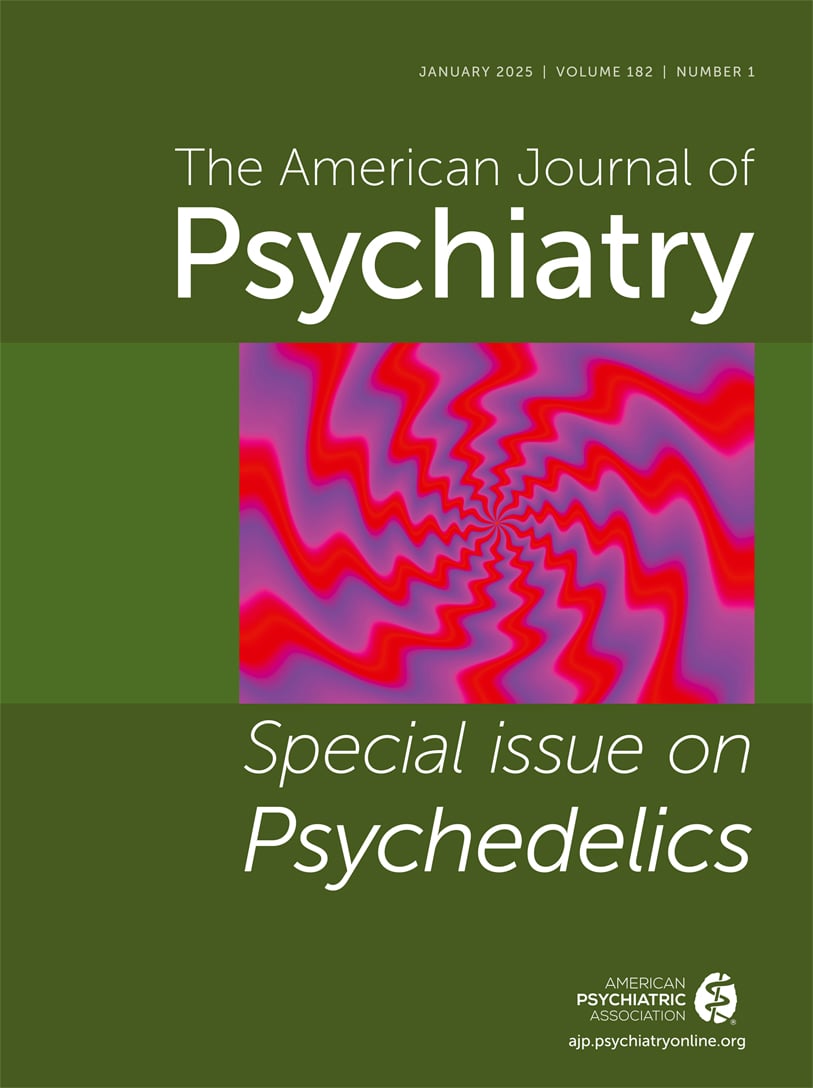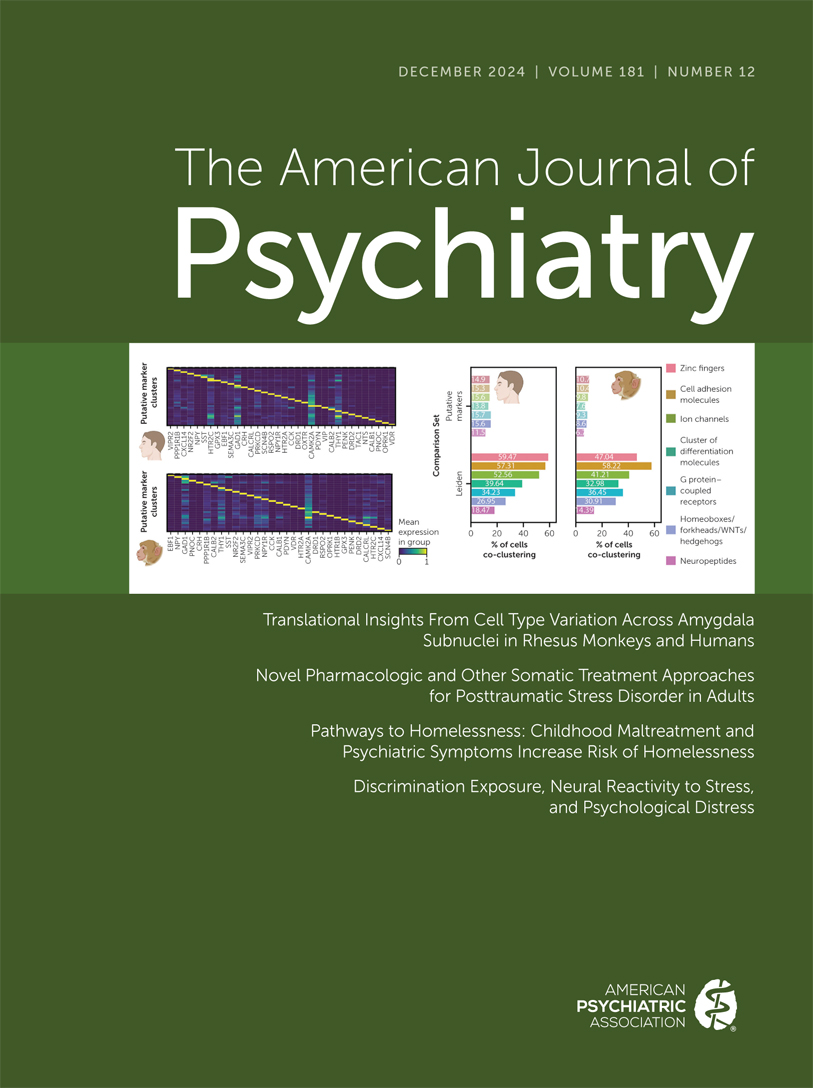American Journal of Psychiatry
- Volume 164
- Number 12
- December 2007
In This Issue
Editorial
Commentary
Images in Neuroscience
Reviews and Overviews
Publication date: 01 December 2007
Pages1791–1802Objective: This study evaluated the effects of cognitive remediation for improving cognitive performance, symptoms, and psychosocial functioning in schizophrenia. Method: A meta-analysis was conducted of 26 randomized, ...
https://doi.org/10.1176/appi.ajp.2007.07060906Introspections
Treatment in Psychiatry
Clinical Case Conference
Article
Publication date: 01 December 2007
Pages1817–1824Objective: This study estimated the risk of recurrence of mood episodes among women with a history of bipolar disorder who continued or discontinued treatment with mood stabilizers during pregnancy. Method: In a prospective ...
https://doi.org/10.1176/appi.ajp.2007.06101639Publication date: 01 December 2007
Pages1825–1831Objective: This study compared the ways in which psychiatrists and nonpsychiatrists interpret the relationship between religion/spirituality and health and address religion/spirituality issues in the clinical encounter. Method: ...
https://doi.org/10.1176/appi.ajp.2007.06122088Publication date: 01 December 2007
Pages1832–1841Objective: The authors sought to test the hypothesis that in patients with borderline personality disorder, the ventromedial prefrontal cortex and associated regions would not be activated during a task requiring motor inhibition in the setting ...
https://doi.org/10.1176/appi.ajp.2007.06010126Publication date: 01 December 2007
Pages1842–1849Objective: Individuals with anorexia nervosa are known to be ascetic and able to sustain self-denial of food as well as most comforts and pleasures in life. Building on previous findings of altered striatal dopamine binding in anorexia nervosa, ...
https://doi.org/10.1176/appi.ajp.2007.07040575Publication date: 01 December 2007
Pages1850–1857Objective: The brain regions that are critically involved in the pathophysiology of anorexia nervosa have not been clearly elucidated. Moreover, decrease in cerebral tissue during extreme malnutrition has been demonstrated repeatedly in ...
https://doi.org/10.1176/appi.ajp.2007.06111861Publication date: 01 December 2007
Pages1858–1865Objective: The serotonin transporter (5-HTT) is a key target for selective serotonin reuptake inhibitors and may be involved in the pathophysiology of major depression. It is now possible to image 5-HTT directly in the human brain, but results ...
https://doi.org/10.1176/appi.ajp.2007.06111933Publication date: 01 December 2007
Pages1866–1872Objective: One of the most important controversies regarding depressive personality disorder is the overlap with mood disorders. The aim of this study was to estimate the genetic and environmental sources of covariance between depressive ...
https://doi.org/10.1176/appi.ajp.2007.07010045Publication date: 01 December 2007
Pages1873–1880Objective: Pupil dilation provides a quantitative index of the temporal pattern of brain reactivity to emotional stimuli. Previous reports indicate that depressed adults show sustained pupil dilation to emotional words, but this phenomenon has ...
https://doi.org/10.1176/appi.ajp.2007.06111816Publication date: 01 December 2007
Pages1881–1889Objective: Proton magnetic resonance spectroscopy ( 1 H-MRS) has been increasingly used to examine striatal neurochemistry in adult major depressive disorder. This study extends the use of this modality to pediatric major ...
https://doi.org/10.1176/appi.ajp.2007.06122032Publication date: 01 December 2007
Pages1890–1899Objective: Factors underlying progressive brain volume changes in schizophrenia remain poorly understood. The authors investigated whether a gene polymorphism influencing neuroplasticity may contribute to longitudinal brain volume alterations. ...
https://doi.org/10.1176/appi.ajp.2007.05111903Publication date: 01 December 2007
Pages1900–1906Objective: Endophenotypes have been proposed to identify the genetic and biological substrates of complex disorders. Three physiological inhibitory endophenotypes of large effect size in schizophrenia include suppression of P50 auditory evoked ...
https://doi.org/10.1176/appi.ajp.2007.06010017Letters to the Editor
Corrections
Book Forum
Books Received
Annual Author Index
Past Issues
View Issues Archive
Vol. 182 | No. 3

Vol. 182 | No. 2

Vol. 182 | No. 1
